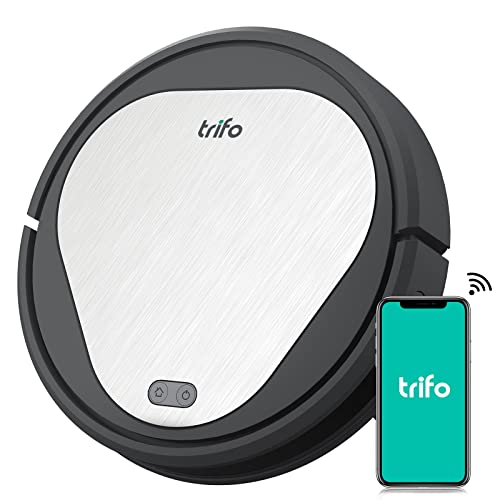The Benefits of Robot Vacuums
Robot vacuum cleaners generally require less maintenance than traditional vacuums. They will need to be cleaned frequently (and washed when the manufacturer suggests it) and wiped to remove hairs from their brushes.

Models equipped with intelligent mapping capabilities that allow you to view the map of your home and those that allow you to establish no-go zones are ideal. If you have pets, think about models that can distinguish between pet hair and other dirt.
They're more efficient
If you're someone with only a short amount of time to maintain and clean your home, then a robot vacuum is a good investment. They can't replace an upright or a canister cleaner, but they can reduce the amount of dust and dirt that can be found in your home. They also help to cut the number of bacteria and allergens that can cause allergies. They are usually much quieter than traditional vacuum cleaners, however, they still require a certain level of maintenance.
Many robotic vacuum cleaners have an air filter that must be cleaned and emptying on a regular basis. It is also necessary to replace the batteries. Some models include HEPA filters which can reduce allergies and capture smaller particles. These filters should be changed every 3 to 4 cycles, or as per the manufacturer's guidelines.
Robot vacuums are frequently worried about their potential to harm furniture, walls and other things. These fears are unfounded as the majority of models are programmed to be allowed into certain areas of the home and are able to create virtual walls to stop them from entering restricted areas.
Most robot vacuums come with sensors built-in that can recognize the type of floor and adjust the settings accordingly. This lets them clean a variety surfaces, including wood, carpet and tile. They can even detect barriers and stairs, and automatically change direction if they come across them to prevent damage.
The methodical back-andforth cleaning motion that robots rely on helps ensure that all the nooks and crannies of your home are cleaned. Additionally, some models are capable of doing double duty as automated robot mops. My experience with mopping capabilities of these machines has been less than stellar.
It's more convenient
In contrast to traditional vacuum cleaners which require you to plug them into an outlet, robots are completely cordless and can run completely on their own. They are usually quiet and won't disturb your sleep. They can be programmed to clean your home even if you're not at home.
Most robots are also much smaller than the typical stick vacuum, meaning they require less space in your home. They are simple to store under your bed or in your closet. You can also transport them from room to room.
Certain robots have self-emptying features, which means you don't have to empty their trash bins manually after every cleaning session. If you have a mop model that comes with a large tank of water that can last for a long time.
The machines utilize sensors to detect changes in the floor's surface and automatically adjust their settings to get the best results. This allows you to wash the entire house at one time, without having to choose between carpet, hardwood, or tile.
The methodical back-and-forth motion they use is similar to the way that people move when cleaning rooms, which ensures that every corner and crevice is covered. Advanced models also make use of lasers or cameras to create real-time maps of your home, so they can navigate around furniture and other obstacles.
In addition, the majority of robots are able to recharge themselves and return to their charging base when they require to be replenished. This gives you more time to concentrate on other things or spend your time doing something you enjoy. And since they're connected to your Wi-Fi, you'll be able to control them using an app on your smartphone.
It's important to remember that robot vacuums are more expensive than stick vacuums and don't have the same warranty as traditional appliances. These devices usually only have an initial warranty of a couple of years, which is not very long.
They're more flexible
The appeal of a robotic vacuum cleaner is that the cleaning can be performed without the involvement of the user. There's no cord or hose to manage, and you can operate them using a remote or an app for your smartphone. A lot of them can be programmed to clean themselves, making them perfect for hands-free daily cleaning.
You can also control robot vacuums through voice commands if you own an appropriate smart home device like Amazon Alexa or Google Assistant. This allows people who are older or have mobility issues to utilize the robot vacuums. Certain robot vacuums map your floor plan, and you can choose certain rooms to be cleaned by using an app or voice command.
Robots are quieter than upright or handheld vacuums. Instead of wires which need to be moved around or tangled with electrical wires, they utilize batteries. They do not require physical plugging into and out of rooms to room. They're generally quieter too, with some operating at the same level of sound as a refrigerator. This makes them perfect for homes with sensitive families, particularly those with pets or kids terrified of vacuums that are traditional.
Another benefit of robot vacuums is that they typically require less maintenance than traditional vacuums. They are smaller and require less space. They also don't require cords or hoses. The majority of models come with dirt bins or bags that needs to be cleaned on a regular basis and the brush rollers need to be cleaned regularly. In general, robots only work when they're switched on and placed in the room which they're designed to clean.
As with any technology, however there are disadvantages to robot vacuum cleaners. One of them is that they are more expensive than other types of vacuums. They are also slower in completing the task than conventional models. Although most robots will not slide down the stairs or smudge your furniture, they are still susceptible to clogging and getting stuck.
They're more expensive
Robots can be pretty expensive, especially when you go for the latest models with the most advanced features. If you're willing to spend a bit more, it's possible that a premium model can save you money in the long run. For example, budget robo-vacs typically come with smaller dust bags and brushes which need to be replaced more frequently than more expensive counterparts. This adds up over time and can increase the cost of ownership.
A cheaper model is more prone to malfunction and go rogue than a high-end model. Having to pay for repairs or replacing motors and batteries is another hidden expense of a bargain-basement robot.
In comparison, premium models come with a range of innovative features that make them more efficient and comfortable to use than traditional vacuums. Features such as advanced navigation, object recognition and mopping are now standard among robot vacuums. The more expensive models will have larger battery capacities with a longer lifespan, as well as superior quality materials.
While robot vacuums are excellent for general cleaning, they're not magical and, depending on the model you choose it could struggle to get into tight corners or clean floors with textured surfaces. In these situations the supervision of an adult and a thorough manual deep clean is required.
Apart from that robot vacs are excellent at cleaning a variety of surfaces, including bare floors and hardwood floors, carpet and Linoleum. The robot vacs can be programmed via a smartphone application to clean at specific times. This is a fantastic option for busy homeowners. They are not a substitute for the regular mop or vacuum, so you should still sweep and mop your house periodically. best robot vacuum for hardwood floors -quality mop with microfiber pads and a bucket of water will ensure you get the best results from your robot vac.
